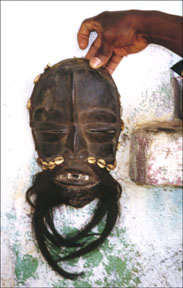| AYA (Fern) |
FOLKLORE, ORAL TRADITIONS
 ". . . Orality is the basis of the reclamation of the African voice in African cinema. By functioning as griots or bards, modern African filmmakers are reserving in cinema a new space within which a critique of both past and present can begin. It is in this third space, outside both the bounds of tradition and Westernized influences, that an African-shaped interpretation of identity can be explored . . ." Carrie Peplinski.
". . . Orality is the basis of the reclamation of the African voice in African cinema. By functioning as griots or bards, modern African filmmakers are reserving in cinema a new space within which a critique of both past and present can begin. It is in this third space, outside both the bounds of tradition and Westernized influences, that an African-shaped interpretation of identity can be explored . . ." Carrie Peplinski.
In a recent internet article, "Oral Traditions and Weapons of Resistance: The Modern African Filmmaker as Griot" (htp://www.und.ac.za/und/ccms/africaprog/griot.htm), Carrie Peplinski highlights "African forms of orality" and speaks of the ways in which these"inform arguments against colonialism and neo-colonialism." Noting Stoller's (1992) observation that the griot (travelling stoyteller) acts as a protector and preserver of societal knowledge, Peplinski tells her reader that "some African filmmakers represent a melding of traditional forms of storytelling with modern technologies, creating a new social/political medium through which African identities are both formed and given voice." These are exciting observations.
I like Peplinski's description of the "third space." Maybe I like it because of its nod in the direction of Victor Turner's "liminality" (although Peplinski doesn't identify it as such). Maybe I like it because of its humility and its recognition of mutivocality and the potential for "morphing" from identity to identity without some outsider saying "Hey, that's wrong" or "That doesn't match my findings and the ethnographic descriptions and monographs I've read. . . ." Something about new meanings that are created in that third space . . .
When I think of folkore and oral tradition, I think of Laura Bohannon and "Shakespeare in the Bush" and the delightful frustration of tales that don't translate. I remember laughing out loud as Bohannon described her rendition of Hamlet viewing his father's ghost and the way in which it was greeted with interpretations that were consonant with the worldview and life experiences of the audience but far from any interpretation she could have developed given hers. I remember that I learned from that story that within cultures reliant upon and expert in oral tradition the story is never finished . There is no final authorized version. It is a different framing of time and space. Maybe it is the "third space."
Mark Turner's, The Literary Mind (1996) suggests that "story, projection and parable" make every day life possible for all of us. Turner posits that the "literary mind" is a "fundamental mind" and that story is its basic principle. He says that "we interpret every level of our experience by means of parable." He speaks of meaning as "alive" and "active" and he talks about the ways in which "parable carries meaning across at least two mental spaces." Turner speaks of the ability (necessity) of the human mind for creating "blended spaces" whether in interpreting a folktale or reading Dante's Inferno. The spaces he talks about are "input" spaces and Turner focuses on a micro-analysis of the process that we use to compose a story, but he is, nevertheless, speaking of the "spaces" that "can reveal latent contradictions and coherences between previously separated elements." The third space?
Michael Joyce in his Of Two Minds: Hypertext, Pedagogy and Poetics (1995) talks about his idea, based on Umberto Eco's "open text" to create what Eco has called the work in movement." Joyce has developed a program called "STORYSPACE" as "an attempt to develop a text-processing tool to enable writers of interactive presentations to exploit mutiplicities." Joyce hopes that Storyspace might be used "to create a novel as subtle and mutiple as oral narratives, but with the referential and coherent richness of in-printed relational works such as those of Sterne, Joyce, Cortazar and others." He sees these texts as a merging of "process and product" and he makes the comparison with Baroque themes and variations or jazz improvisations. Sounds like the third space to me.
Text: Joanne Munroe, WCC IDS Instructor
Cote d'Ivoire Dan mask photo: Kathryn Roe, WCC Art Instructor
© WCC African Study Project